Abstract
OBJECTIVES--To compare the performance of a disease specific and a general health questionnaire in assessing changes resulting from total hip replacement. DESIGN--Two stage prospective study of patients undergoing total hip replacement surgery involving an assessment at a clinic before and six months after surgery. 60(32%) patients were followed up by post. SETTING--Outpatient departments at a specialist orthopaedic hospital and peripheral clinics within Oxfordshire. PATIENTS--188 patients admitted for unilateral total hip replacement between February and mid-August 1994. MAIN MEASURES--Patients' self assessed scores with the 12 item Oxford hip score and SF-36 general health questionnaire together with surgeons' assessment with Charnley hip score obtained before and again at six months after surgery. RESULTS--186 patients were followed up six months after total hip replacement; a subsample (n=60) by post. Of the 60 postal patients, 59(98.3%) fully completed the Oxford hip score compared with 44(73.3%) who fully completed the SF-36. For the followup sample as a whole, post operative changes in scores produced a large effect size of 2.75 on the Oxford hip score, compared with -1.89 physical function (SF-36), -2.13 pain (SF-36). With the exception of physical function and role (physical), postoperative SF-36 scores were shown to be similar to or better than those found by two population surveys on patients of comparable age. The responsiveness of a disease specific questionnaire, the Oxford hip score, and relevant sections of a general questionnaire, SF-36, were found to be similar as assessed by three different criteria. CONCLUSIONS--A disease specific questionnaire, the Oxford hip score, and a general state of health questionnaire, SF-36, performed similarly in assessing outcomes of total hip replacement except that the disease specific questionnaire resulted in a higher completion rate and greater responsiveness in some sections. On the other hand the general health questionnaire drew attention to broader problems of physical function not considered by the Oxford hip score. The health questionnaires examined here offer a valid and practical means of monitoring outcomes of hip replacement surgery.
Full text
PDF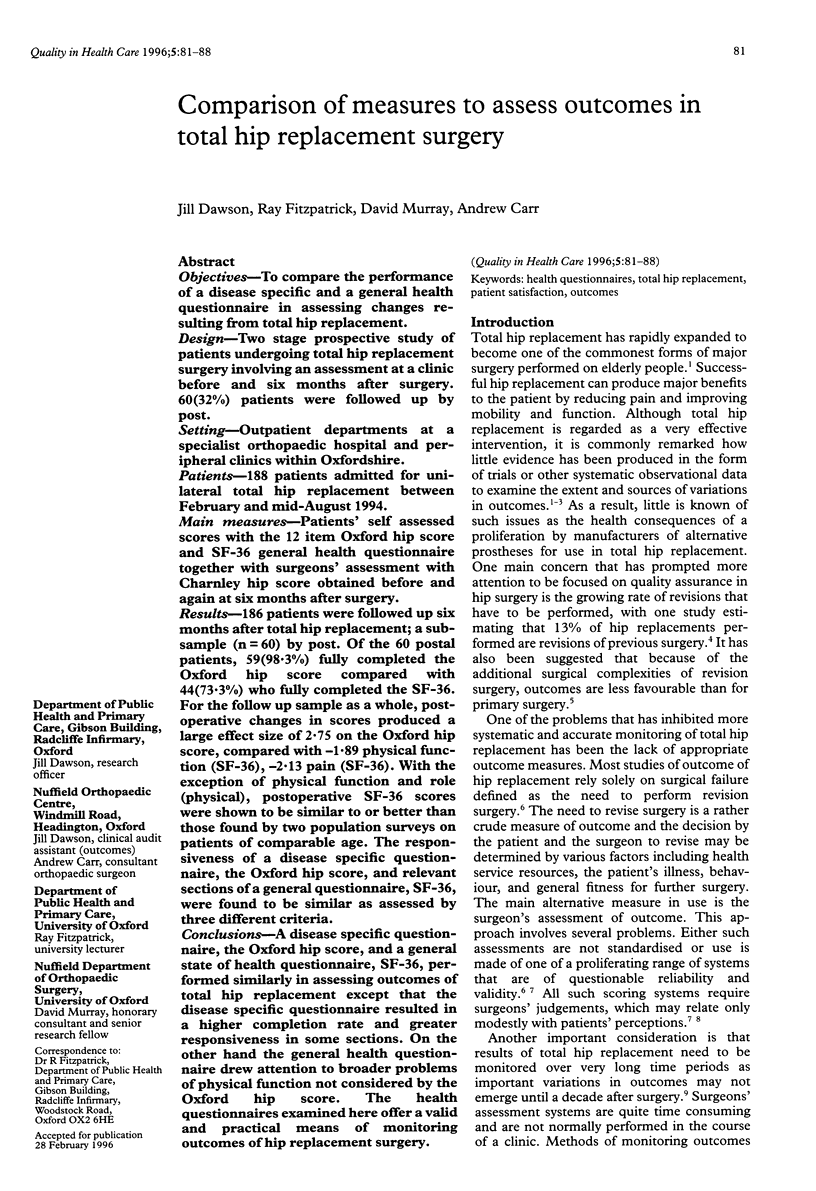
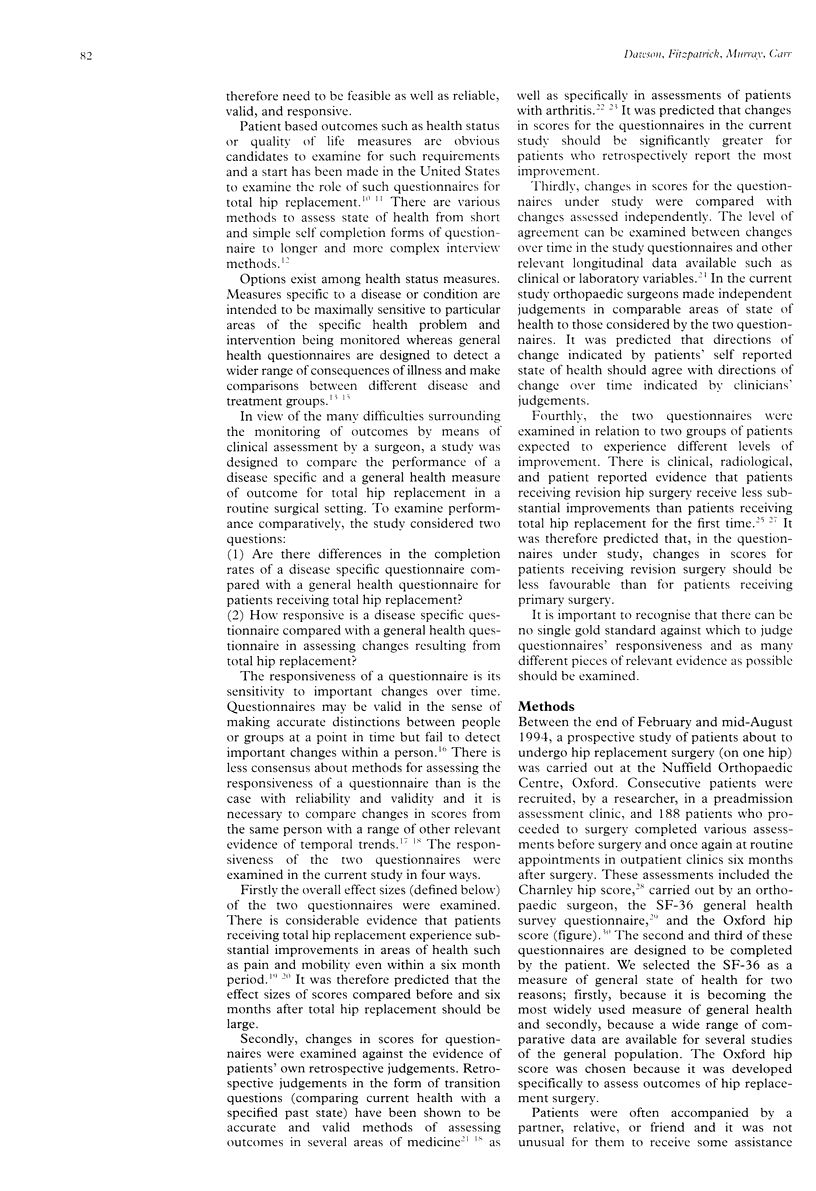
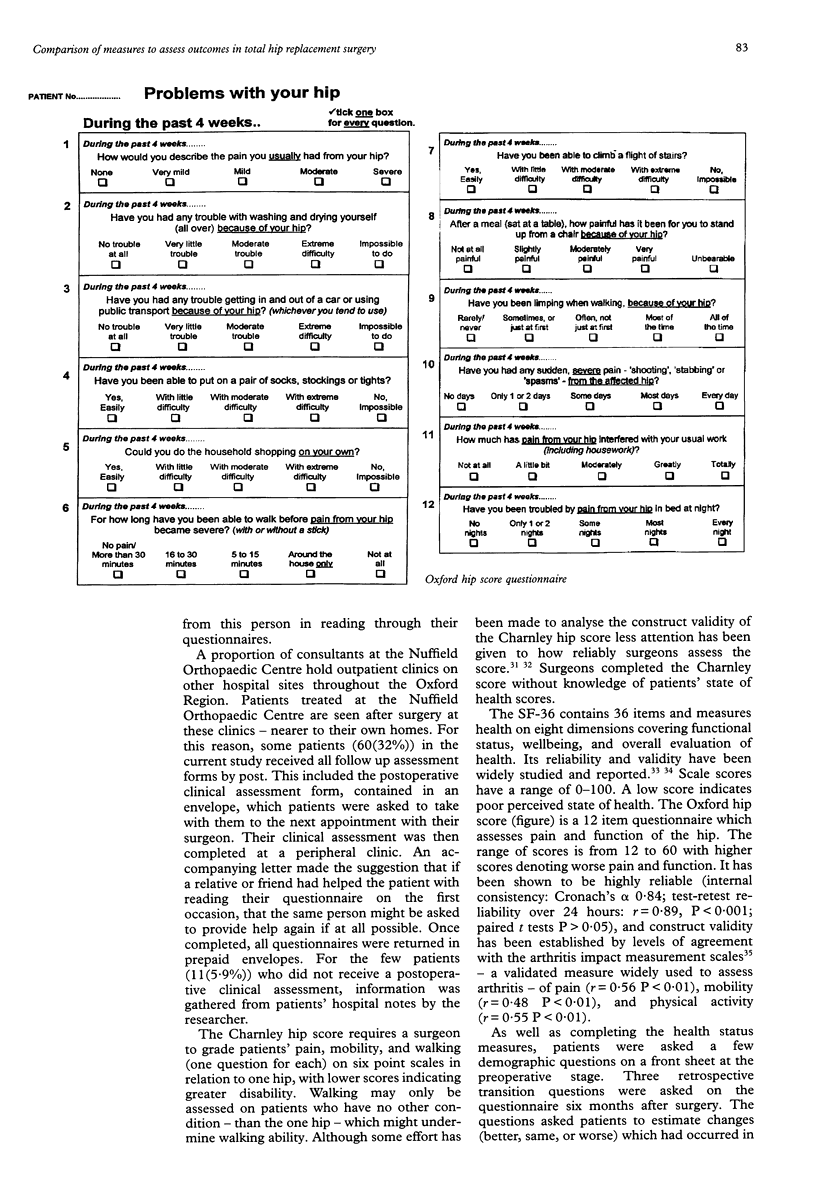
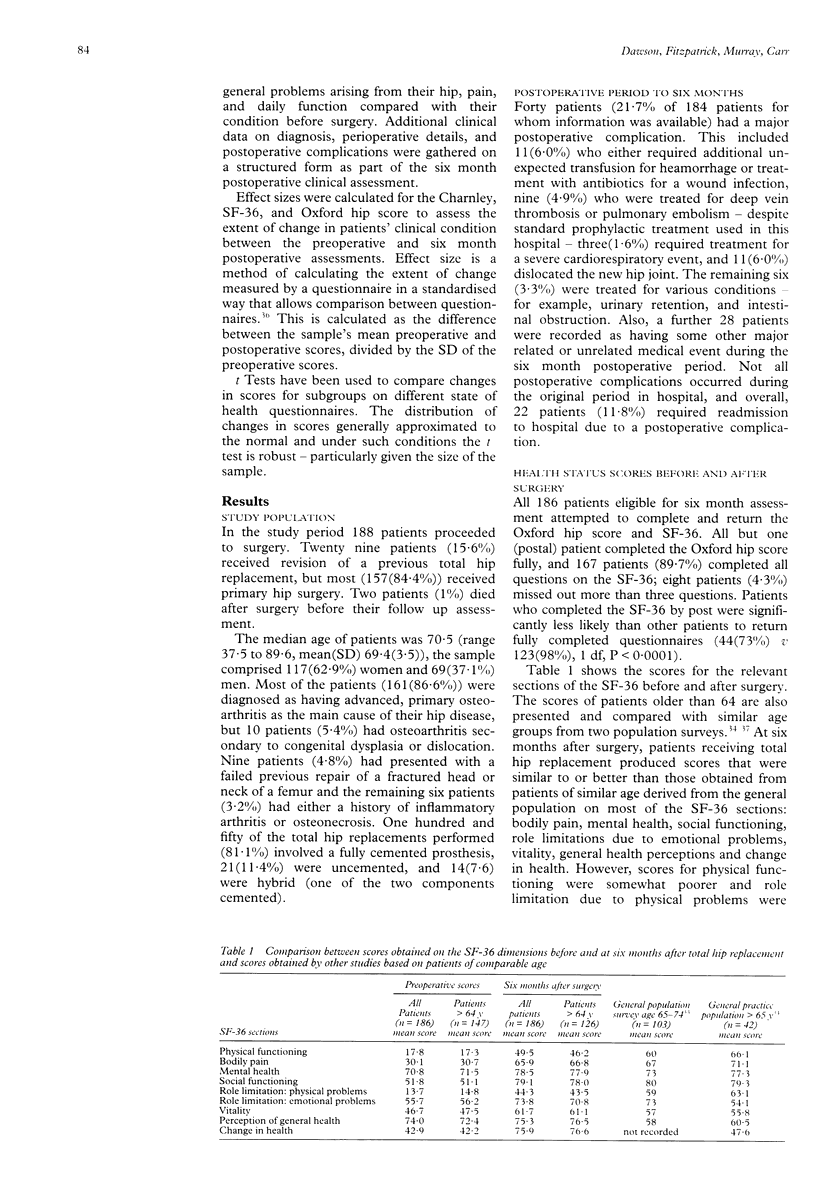
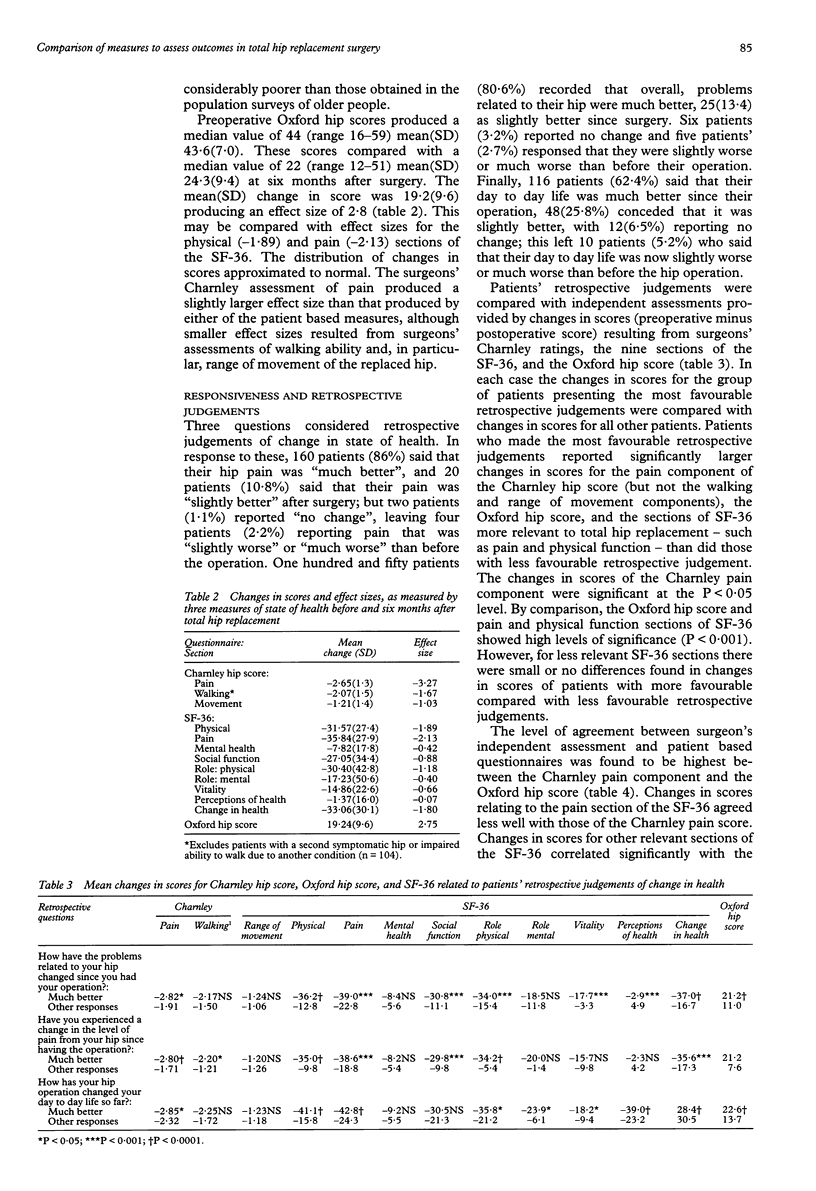
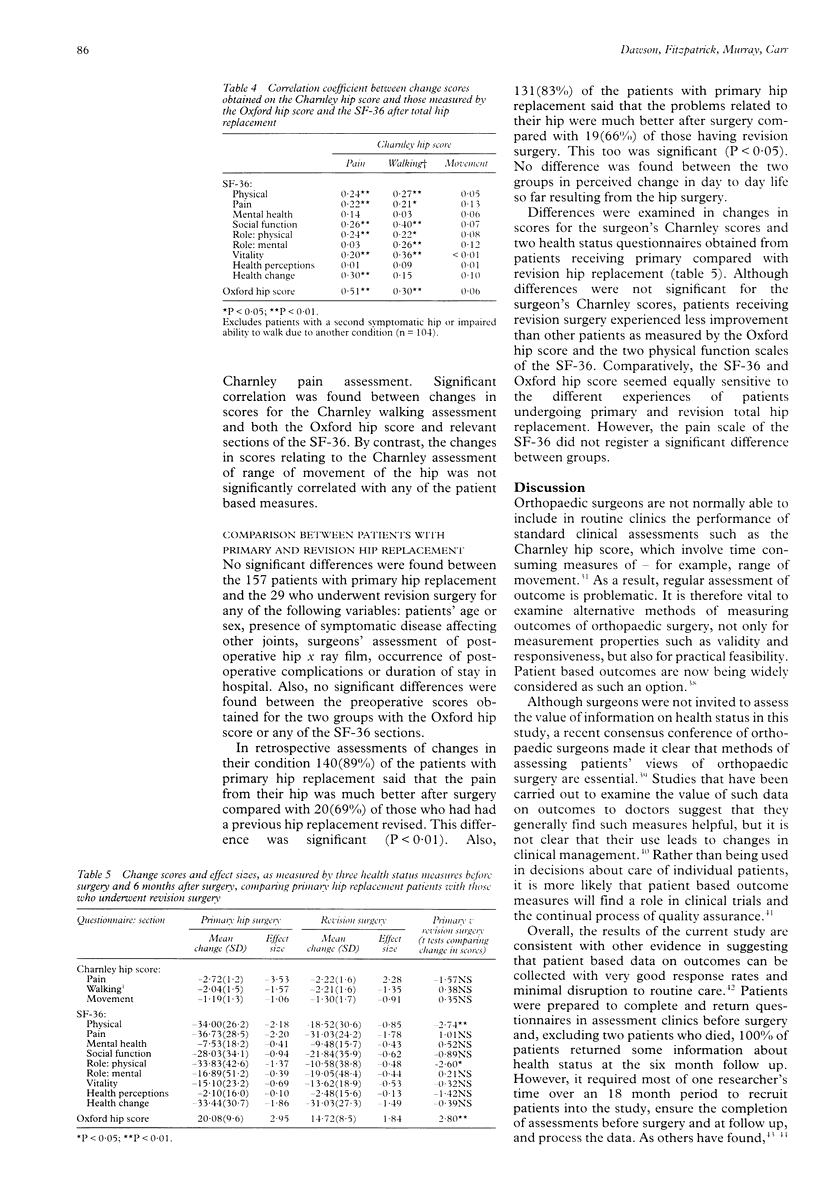

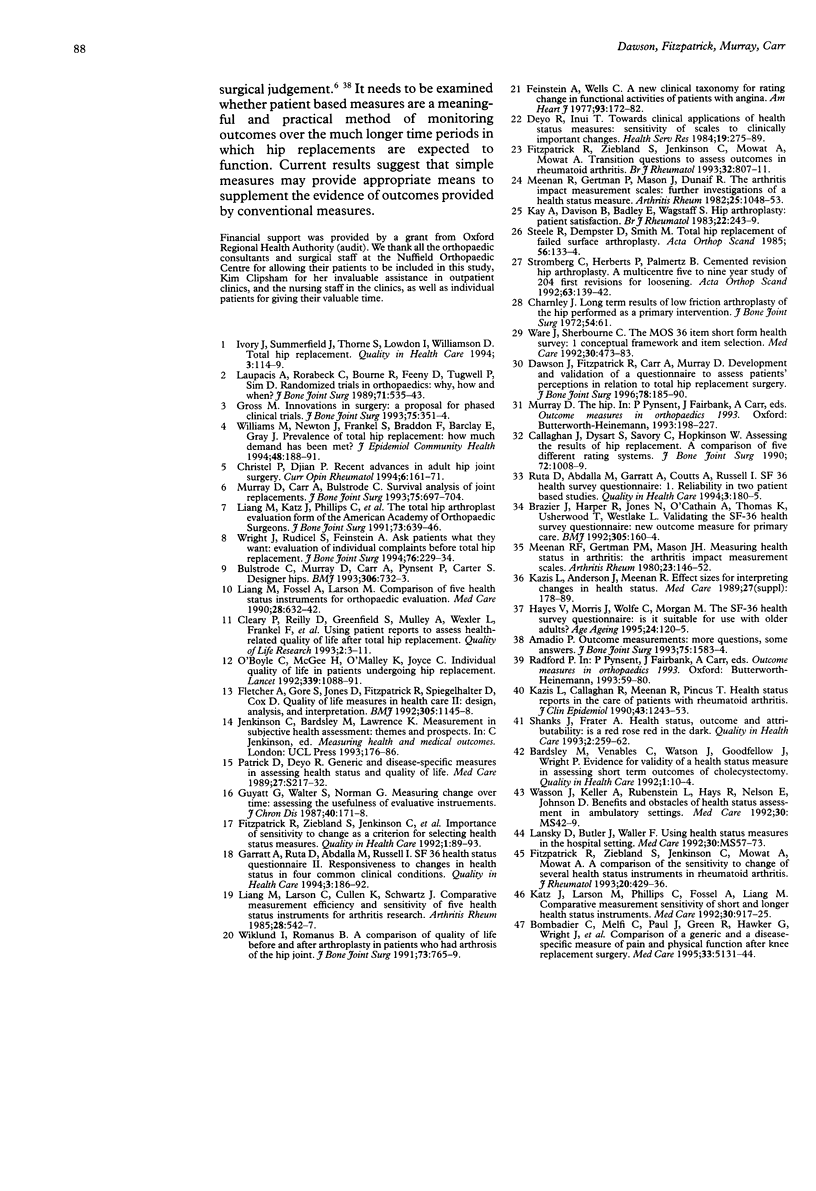
Selected References
These references are in PubMed. This may not be the complete list of references from this article.
- Amadio P. C. Outcomes measurements. J Bone Joint Surg Am. 1993 Nov;75(11):1583–1584. doi: 10.2106/00004623-199311000-00001. [DOI] [PubMed] [Google Scholar]
- Bardsley M. J., Venables C. W., Watson J., Goodfellow J., Wright P. D. Evidence for validity of a health status measure in assessing short term outcomes of cholecystectomy. Qual Health Care. 1992 Mar;1(1):10–14. doi: 10.1136/qshc.1.1.10. [DOI] [PMC free article] [PubMed] [Google Scholar]
- Brazier J. E., Harper R., Jones N. M., O'Cathain A., Thomas K. J., Usherwood T., Westlake L. Validating the SF-36 health survey questionnaire: new outcome measure for primary care. BMJ. 1992 Jul 18;305(6846):160–164. doi: 10.1136/bmj.305.6846.160. [DOI] [PMC free article] [PubMed] [Google Scholar]
- Bulstrode C. J., Murray D. W., Carr A. J., Pynsent P. B., Carter S. R. Designer hips. BMJ. 1993 Mar 20;306(6880):732–733. doi: 10.1136/bmj.306.6880.732. [DOI] [PMC free article] [PubMed] [Google Scholar]
- Callaghan J. J., Dysart S. H., Savory C. F., Hopkinson W. J. Assessing the results of hip replacement. A comparison of five different rating systems. J Bone Joint Surg Br. 1990 Nov;72(6):1008–1009. doi: 10.1302/0301-620X.72B6.2246281. [DOI] [PubMed] [Google Scholar]
- Christel P., Djian P. Recent advances in adult hip joint surgery. Curr Opin Rheumatol. 1994 Mar;6(2):161–171. doi: 10.1097/00002281-199403000-00008. [DOI] [PubMed] [Google Scholar]
- Cleary P. D., Reilly D. T., Greenfield S., Mulley A. G., Wexler L., Frankel F., McNeil B. J. Using patient reports to assess health-related quality of life after total hip replacement. Qual Life Res. 1993 Feb;2(1):3–11. doi: 10.1007/BF00642884. [DOI] [PubMed] [Google Scholar]
- Dawson J., Fitzpatrick R., Carr A., Murray D. Questionnaire on the perceptions of patients about total hip replacement. J Bone Joint Surg Br. 1996 Mar;78(2):185–190. [PubMed] [Google Scholar]
- Deyo R. A., Inui T. S. Toward clinical applications of health status measures: sensitivity of scales to clinically important changes. Health Serv Res. 1984 Aug;19(3):275–289. [PMC free article] [PubMed] [Google Scholar]
- Feinstein A. R., Wells C. K. A new clinical taxonomy for rating change in functional activities of patients with angina pectoris. Am Heart J. 1977 Feb;93(2):172–182. doi: 10.1016/s0002-8703(77)80308-6. [DOI] [PubMed] [Google Scholar]
- Fitzpatrick R., Ziebland S., Jenkinson C., Mowat A., Mowat A. A comparison of the sensitivity to change of several health status instruments in rheumatoid arthritis. J Rheumatol. 1993 Mar;20(3):429–436. [PubMed] [Google Scholar]
- Fitzpatrick R., Ziebland S., Jenkinson C., Mowat A., Mowat A. Importance of sensitivity to change as a criterion for selecting health status measures. Qual Health Care. 1992 Jun;1(2):89–93. doi: 10.1136/qshc.1.2.89. [DOI] [PMC free article] [PubMed] [Google Scholar]
- Fitzpatrick R., Ziebland S., Jenkinson C., Mowat A., Mowat A. Transition questions to assess outcomes in rheumatoid arthritis. Br J Rheumatol. 1993 Sep;32(9):807–811. doi: 10.1093/rheumatology/32.9.807. [DOI] [PubMed] [Google Scholar]
- Fletcher A., Gore S., Jones D., Fitzpatrick R., Spiegelhalter D., Cox D. Quality of life measures in health care. II: Design, analysis, and interpretation. BMJ. 1992 Nov 7;305(6862):1145–1148. doi: 10.1136/bmj.305.6862.1145. [DOI] [PMC free article] [PubMed] [Google Scholar]
- Garratt A. M., Ruta D. A., Abdalla M. I., Russell I. T. SF 36 health survey questionnaire: II. Responsiveness to changes in health status in four common clinical conditions. Qual Health Care. 1994 Dec;3(4):186–192. doi: 10.1136/qshc.3.4.186. [DOI] [PMC free article] [PubMed] [Google Scholar]
- Guyatt G., Walter S., Norman G. Measuring change over time: assessing the usefulness of evaluative instruments. J Chronic Dis. 1987;40(2):171–178. doi: 10.1016/0021-9681(87)90069-5. [DOI] [PubMed] [Google Scholar]
- Hayes V., Morris J., Wolfe C., Morgan M. The SF-36 health survey questionnaire: is it suitable for use with older adults? Age Ageing. 1995 Mar;24(2):120–125. doi: 10.1093/ageing/24.2.120. [DOI] [PubMed] [Google Scholar]
- Ivory J. P., Summerfield J., Thorne S., Lowdon I. M., Williamson D. M. Total hip replacement. Qual Health Care. 1994 Jun;3(2):114–119. doi: 10.1136/qshc.3.2.114. [DOI] [PMC free article] [PubMed] [Google Scholar]
- Katz J. N., Larson M. G., Phillips C. B., Fossel A. H., Liang M. H. Comparative measurement sensitivity of short and longer health status instruments. Med Care. 1992 Oct;30(10):917–925. doi: 10.1097/00005650-199210000-00004. [DOI] [PubMed] [Google Scholar]
- Kay A., Davison B., Badley E., Wagstaff S. Hip arthroplasty: patient satisfaction. Br J Rheumatol. 1983 Nov;22(4):243–249. doi: 10.1093/rheumatology/22.4.243. [DOI] [PubMed] [Google Scholar]
- Kazis L. E., Callahan L. F., Meenan R. F., Pincus T. Health status reports in the care of patients with rheumatoid arthritis. J Clin Epidemiol. 1990;43(11):1243–1253. doi: 10.1016/0895-4356(90)90025-k. [DOI] [PubMed] [Google Scholar]
- Lansky D., Butler J. B., Waller F. T. Using health status measures in the hospital setting: from acute care to 'outcomes management'. Med Care. 1992 May;30(5 Suppl):MS57–MS73. doi: 10.1097/00005650-199205001-00006. [DOI] [PubMed] [Google Scholar]
- Liang M. H., Fossel A. H., Larson M. G. Comparisons of five health status instruments for orthopedic evaluation. Med Care. 1990 Jul;28(7):632–642. doi: 10.1097/00005650-199007000-00008. [DOI] [PubMed] [Google Scholar]
- Liang M. H., Katz J. N., Phillips C., Sledge C., Cats-Baril W. The total hip arthroplasty outcome evaluation form of the American Academy of Orthopaedic Surgeons. Results of a nominal group process. The American Academy of Orthopaedic Surgeons Task Force on Outcome Studies. J Bone Joint Surg Am. 1991 Jun;73(5):639–646. [PubMed] [Google Scholar]
- Liang M. H., Larson M. G., Cullen K. E., Schwartz J. A. Comparative measurement efficiency and sensitivity of five health status instruments for arthritis research. Arthritis Rheum. 1985 May;28(5):542–547. doi: 10.1002/art.1780280513. [DOI] [PubMed] [Google Scholar]
- Meenan R. F., Gertman P. M., Mason J. H., Dunaif R. The arthritis impact measurement scales. Further investigations of a health status measure. Arthritis Rheum. 1982 Sep;25(9):1048–1053. doi: 10.1002/art.1780250903. [DOI] [PubMed] [Google Scholar]
- Meenan R. F., Gertman P. M., Mason J. H. Measuring health status in arthritis. The arthritis impact measurement scales. Arthritis Rheum. 1980 Feb;23(2):146–152. doi: 10.1002/art.1780230203. [DOI] [PubMed] [Google Scholar]
- Murray D. W., Carr A. J., Bulstrode C. Survival analysis of joint replacements. J Bone Joint Surg Br. 1993 Sep;75(5):697–704. doi: 10.1302/0301-620X.75B5.8376423. [DOI] [PubMed] [Google Scholar]
- O'Boyle C. A., McGee H., Hickey A., O'Malley K., Joyce C. R. Individual quality of life in patients undergoing hip replacement. Lancet. 1992 May 2;339(8801):1088–1091. doi: 10.1016/0140-6736(92)90673-q. [DOI] [PubMed] [Google Scholar]
- Patrick D. L., Deyo R. A. Generic and disease-specific measures in assessing health status and quality of life. Med Care. 1989 Mar;27(3 Suppl):S217–S232. doi: 10.1097/00005650-198903001-00018. [DOI] [PubMed] [Google Scholar]
- Ruta D. A., Abdalla M. I., Garratt A. M., Coutts A., Russell I. T. SF 36 health survey questionnaire: I. Reliability in two patient based studies. Qual Health Care. 1994 Dec;3(4):180–185. doi: 10.1136/qshc.3.4.180. [DOI] [PMC free article] [PubMed] [Google Scholar]
- Shanks J., Frater A. Health status, outcome, and attributability: is a red rose red in the dark? Qual Health Care. 1993 Dec;2(4):259–262. doi: 10.1136/qshc.2.4.259. [DOI] [PMC free article] [PubMed] [Google Scholar]
- Steele R. A., Dempster D., Smith M. A. Total hip replacement of failed surface arthroplasty. Acta Orthop Scand. 1985 Apr;56(2):133–134. doi: 10.3109/17453678508994337. [DOI] [PubMed] [Google Scholar]
- Ware J. E., Jr, Sherbourne C. D. The MOS 36-item short-form health survey (SF-36). I. Conceptual framework and item selection. Med Care. 1992 Jun;30(6):473–483. [PubMed] [Google Scholar]
- Wasson J., Keller A., Rubenstein L., Hays R., Nelson E., Johnson D. Benefits and obstacles of health status assessment in ambulatory settings. The clinician's point of view. The Dartmouth Primary Care COOP Project. Med Care. 1992 May;30(5 Suppl):MS42–MS49. doi: 10.1097/00005650-199205001-00004. [DOI] [PubMed] [Google Scholar]
- Wiklund I., Romanus B. A comparison of quality of life before and after arthroplasty in patients who had arthrosis of the hip joint. J Bone Joint Surg Am. 1991 Jun;73(5):765–769. [PubMed] [Google Scholar]
- Williams M. H., Newton J. N., Frankel S. J., Braddon F., Barclay E., Gray J. A. Prevalence of total hip replacement: how much demand has been met? J Epidemiol Community Health. 1994 Apr;48(2):188–191. doi: 10.1136/jech.48.2.188. [DOI] [PMC free article] [PubMed] [Google Scholar]
- Wright J. G., Rudicel S., Feinstein A. R. Ask patients what they want. Evaluation of individual complaints before total hip replacement. J Bone Joint Surg Br. 1994 Mar;76(2):229–234. [PubMed] [Google Scholar]


